Within the next 12 months, Adam Seligman, VP of Generative Builders at AWS, believes there will be an inversion of SaaS.
What does that mean? That many of the standard assumptions and ways of doing SaaS will change a lot. Adam has one core belief above all else — “You don’t have to be *this tall* to ride the rides. Anyone should be able to build any Cloud solutions they want. You don’t have to be an expert to be able to build things.”
He believes we’re rapidly approaching that new world where anyone can build a great SaaS product. Keep reading to learn what the four most common SaaS assumptions are, and watch Adam knock each one down with the power of generative AI.
Four Common Assumptions About SaaS
There are many, many assumptions and standard ways of doing SaaS, with four of them being:
- You need deep domain expertise to design the app.
- It’s expensive and time-consuming to build software.
- It’s difficult for customers to configure, integrate, and extend.
- Go-to-Market is expensive and labor-intensive.
Let’s break those ideas down a little.
- #1 You need deep domain expertise to design an app. There’s an assumption that as a founder or Head of Product, you need a deep understanding of the business domain your users are in — how they think and want to work, regulatory and reporting requirements, etc. To build an app for that industry, you need to know a business to build SaaS for it.
- #2 It’s expensive and time-consuming to build software. The assumption is you have to write a lot of code, have a custom UI, a nice look, and fit the users’ needs and flow. The belief is if your product doesn’t work fast, have all of the right features, or a great UX, the customer will bounce. That makes sense. It takes time to build.
- #3 It’s difficult for customers to configure, integrate, and extend. Customers don’t just want a product today. They want one that fits their unique needs and integrates with their data sources and third-party things. The good news is you have a big backlog, and the bad news is you have a big backlog. You have to build a lot of extensibility into the product so customers can self-serve and make adjustments to meet their needs. That’s a big lift, and the universe of things the customer wants gets bigger and bigger.
- #4 GTM is expensive and labor-intensive. There’s this belief that the whole mechanics of getting a SaaS product to market — making them aware, hooking their interest, qualifying, and discovery — takes a lot of time. There are a lot of amazing salespeople in this business, and this is a big chunk of running a great SaaS business or a great GTM motion. Now, it’s time to knock over all of these beliefs with generative AI.
Debunking Traditional SaaS Beliefs
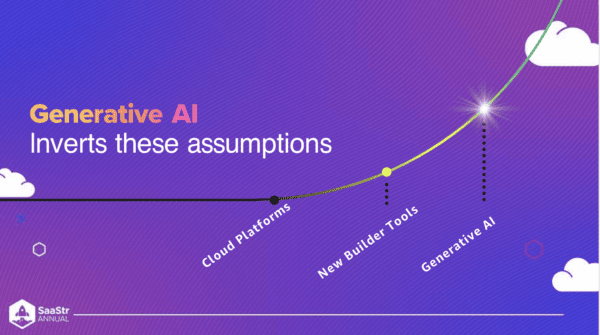
Generative AI inverts all of the assumptions above, and we’re at the start of it, not the end. When these three things come together — Cloud platforms, new builder and dev tools, and generative AI — it creates a tipping point. So, let’s go through each of the common SaaS beliefs and debunk them with AI.
#1 You will be able to build an app without deep domain expertise.
The first assumption is that it requires deep domain expertise to design. Adam came up with the wildest idea he could think of for an app and used Anthrop\c, a large language model company, to help develop the idea.
The idea he typed was: I’d like to create a SaaS application for a veterinary dental practice that serves zoos. Could you write down the core features, data model, and primary functionality the app should have?
AI starts spitting out information. Adam knows nothing about vets or zoos and only a little about SaaS. Yet, Anthrop\c sends out a detailed list of everything like the core features of appointment scheduling, treatment planning, supply tracking, and billing and invoicing. It’s not everything you need for veterinary SaaS, but it’s a start.
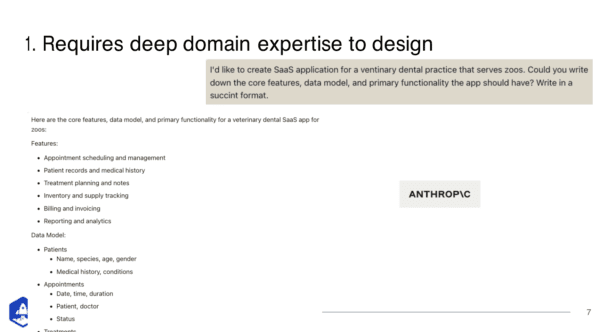
AI, as an assistant, anchors you and allows you to test ideas. It can take a lot of knowledge in the world and express it. This accomplishes the pieces you need to do product definition in SaaS.
What’s the data model? Not a lot of vets do data modeling, so it translates part of the product management function for developers to be able to pick it up and work with it.
The next question to ask your AI assistant is: Are there any specific features around dental work for elephants or pachyderms?
It gives treatment area, sizing, positioning, diet planning, referrals, etc. It’s a lot of knowledge you can use to tease out and express the different elements in your SaaS app. Then you push it even further. The last prompt mentioned laws and guidelines, so Adam asked: For each of these laws and guidelines, provide specific features our app should include for veterinary dental care for elephants in zoos to comply with these regulations.
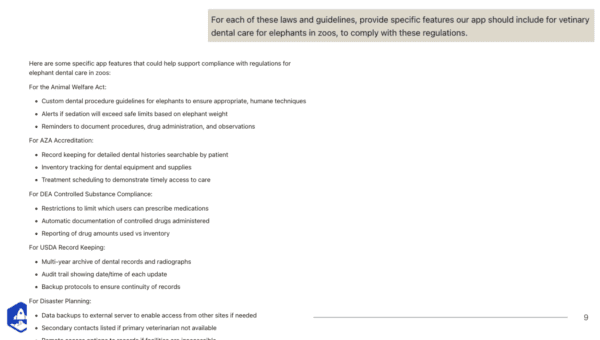
It came up with things like the Animal Welfare Act, controlled substance compliance, USDA record keeping, disaster planning, and more. As a SaaS founder, you might not know all the requirements, so you can use these tools to shape that understanding. It’s not the end of the journey, but Adam is willing to bet that every product manager in the industry will be working like this in the next 12 months. So, that dings the first assumption.
#2 AI will write code and design websites for you.
There are a whole crop of coding assistants popping up that can write code and configure infrastructure like Github Copilot and AWS’ Code Whisperer. It can write test coverage, IEC, and things like refactoring code and correcting errors. All these developers will have agents to help them write faster and faster.
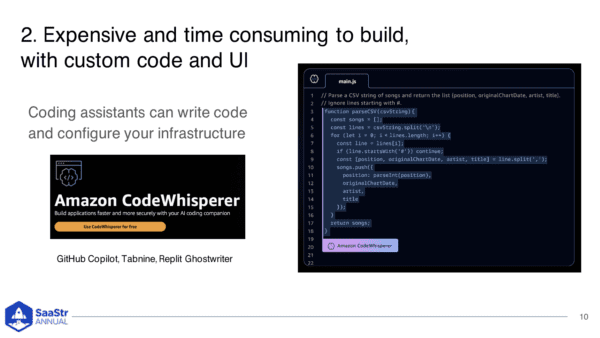
It’s pretty wild, right? This tech that can tell us about elephants and zoos can also write code. And it’s coming fast!
Let’s push this idea further…New tools in the UI and front-end coding space will help with design systems and UI. They do AI-assisted mocks and help you wireframe a website. That means faster cycle times between product and design and testing with customers. Framer is another really cool product for designing websites. You tap in what you need, and it builds an iterative site for you. Designers and product marketers will use tools like this to build and explain products to your customers.
#3 Integration and customization get easier as you get bigger.
Maybe it happens later in your journey as you get bigger, but your customers have unique use cases. Companies like Zapier come in and connect a customer’s SaaS apps together. Historically, your customer knew what Zapier was, and it wasn’t hard, but it was extra work. Coming soon, you’ll be able to enter a prompt that’ll connect Quickbooks to Hubspot to anything else you need.
It’s a cool media automation to help customers get more value out of your SaaS application. In the image below, you’ll see the headline that language models can teach themselves to use these different tools.
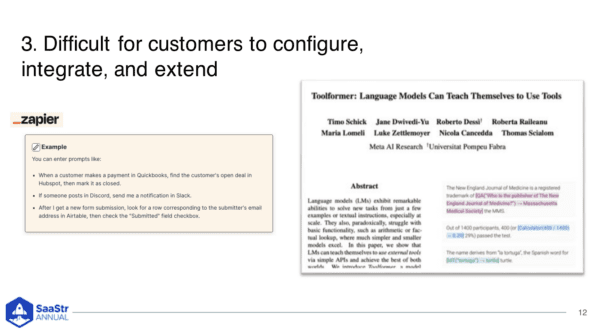
So, when you give your LLM a task, it goes off, and uses those tools to complete it. You’ll see this more generally in the ecosystem.
All of this integration and customization customers want as you get bigger will get easier.
#4 The ability for your teams to show or articulate the value of your product will be more effortless.
There’s a mental model that GTM and the mechanics of it are expensive and labor intensive.
Some things included in that GTM expense are:
- Marketers generate content for awareness
- Sales developer reps work with emails, scripts, and coaching
- Account Executives discover, qualify, and shepherd opportunities
- Sales Engineers demonstrate value and handle questions
SDRs
- Everyone knows about building content for awareness — blog posts, articles, how-to’s, sponsored content, etc. Your SDRs, what do they do? Their goal is to get on the phone and generate interest. They work with giant lists, research, learn call scripts, compare other call scripts, and dial in parallel. AI is now assisting with dialing, cold emailing, and follow-ups.
- Everything described is going to be assisted with ML technology. Let’s say you have a big pool of SDRs and a ton of communications going out. You have 10,000 emails, and 37 of them worked.
- Language models can summarize what it was about the pitch or hook that generated interest.
- It’s not cutting a corner to save time but making sense of a large pool of information and raising the bar for all customer interactions.
AEs
- AEs discover and shepherd the opportunity through. You listen and understand the customers’ needs and translate what your product does into the customer’s needs. Then there’s a process — a demo or proof of value or a security questionnaire. Every one of those things is summarizing and generating from your arsenal of content and translating into a customer story that resonates.
- Foundation models will do that.
Sales Engineers
- The key to selling SaaS is a demo or test environment customized for the customer.
- The more you can tune it for them and it speaks to their needs, the better.
- You preload data, preconfigure screens, team structure, etc.
- It’s the same as the coding stuff. Foundation models will do this for you or with you.
- Sales engineers increase their ability and speed to show or articulate the value of your product to customers.
Overall
- Most teams are probably experimenting with generative AI. It’s coming really fast, and we’re just at the beginning.
- It’s awesome because it creates amazing opportunities for founders to build things.
- It’s not all a single-button solution, but those four areas of SaaS assumptions will become faster and easier.
There’s no better time to build a SaaS business than right now.
“Your ability to build it, to understand customer needs, to get it to market, to support customer requirements and extend them will be easier than it’s ever been before,” Adam shares.

